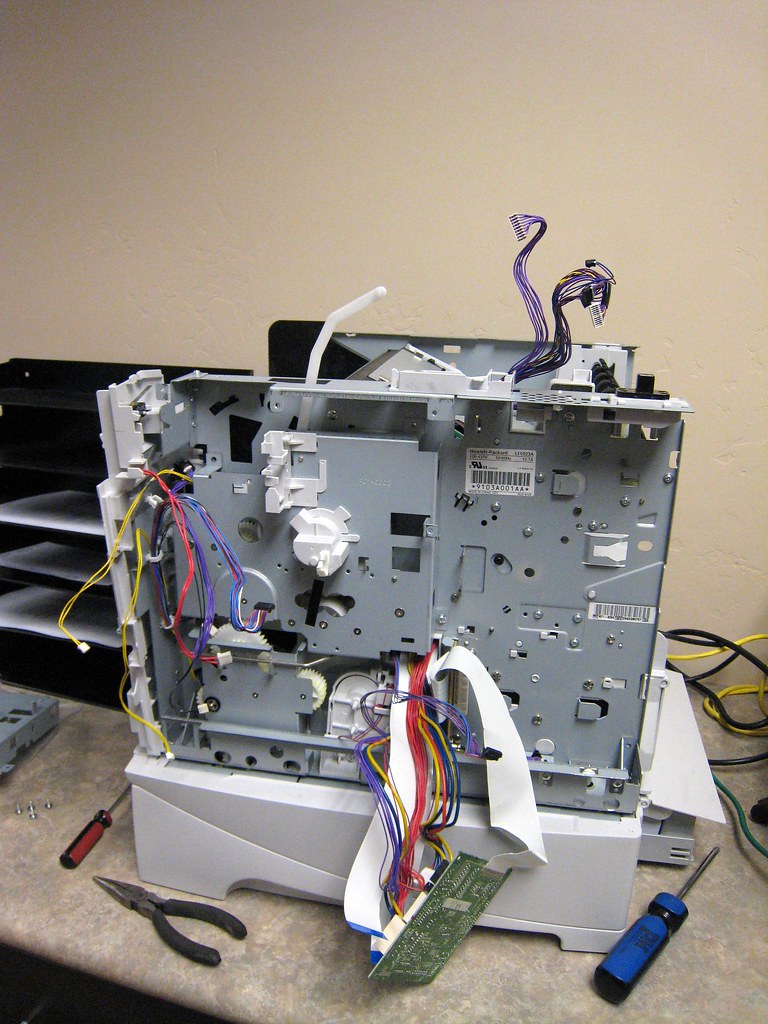*Warning* - Geekiness ahead. Ye be warned.
I will admit that my job is not very hard. I'm still wondering why they haven't replaced me with a trained monkey that knows how to replace a toner cartridge and restart computers. That would cover about 90% of what I do.
Every now and then though, I am presented with a bit of a challenge. Like a printer that is making noises that it shouldn't. Now, when your home inkjet printer makes a weird noise, generally you don't worry about it until it stops printing right? Well it's a little different with the laser printers at the office. When the printer costs $2,500, you want to make sure to nip weird noises in the bud as early as possible.
The thing I like about working on printers is that sometimes you have to play detective. Turn it on, and put your ear all over like a doctor with a stethoscope. Try it with the paper trays in and out. Try it with no toner cartridge. Start taking off panels and see if you can find out where the noise is coming from.
So, on the particular unit that brings this post about, one of the items that often causes noise and is easy to replace is the fuser. Pop the old one out, put a new one in: 10 minutes and you are done. However in this case the noise persisted.
After tearing off as many panels and items as I could while still allowing the printer to function, I decided that it was the main drive assembly causing the high pitched squeal. But of course this part of the machine is behind all the electronics, drive motors, and fans, so I was just taking my best guess that this was the problem:
So I email my suspicions to my boss, who approves the purchase of $50 (thank goodness, a cheap part for once!!!) for the part. A few days later and it is time to install.
*An Important Note* - I am not an HP certified technician, and do not have any real experience of repairing printer. It is kind of like working on my truck - I just figure it out as I go. My boss seems to like this, since it saves us the $150/hr bill that an HP certified technician would charge for the same work.
So I start the tear-down, and I come upon this, the real challenge; the control board with about 30 plugs on it.
Of course some of these wires are soldered to both the printer and the control board, so I can't completely remove it from the printer, and it is forced to hang in my way for the rest of the install. Then I start wrangling all the wiring out of my way so I can get another layer deeper.
About 1/2 hour later and it looks like this:
At this point I stopped taking pictures and just dug in. Out with the old drive assembly, in with the new. And start the hour long process of putting it all back together (and cleaning some other items as I go).
So after 2 hours (saving the company $325 in repair labor that HP quoted for the work) it looks just like this one, which is to say that it looks like a whole printer again:
Then the best part: turning it on. I will admit: often times I don't even care if it is still noisy, so long as it works AT LEAST AS GOOD AS IT DID WHEN I STARTED. There is nothing worse than breaking additional parts and having to make un-necessary purchases to fix my fuck-ups.
In this case, she fired right up AND the noise was gone!!! Hoooraaay!!!
So is it sick that this is probably going to be the highlight of my month at work? I had a lot of fun tearing this thing down!


2 comments:
Good Work!! I love that you're not afraid to just dive in there and roll up the sleeves (after taking the appropriate pictures of course, I mean, you should see the plumbing ones I took for the blog) and getting right to work! Plus? When you spend time on a project and it actually works out well? That is totally the best feeling in the world...
The way I look at it is; what's the worst that is going to happen? So far the worst on a printer has been cracking a plastic side-panel, which was still cheaper to replace than having the certified tech come out. :)
Post a Comment